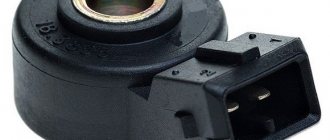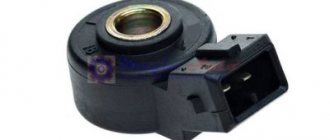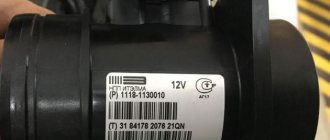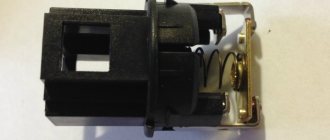Detonation has a negative effect on the Lada Granta engine. It has a destructive effect on the cylinder-piston group and other components. The electronic control module is capable of eliminating detonation.
To do this, he needs to receive information about the operating mode of the motor. The responsibility to monitor the occurrence of detonation is assigned to a special sensor. It promptly detects abnormal ignition of the fuel-air mixture and reports this to the ECU. As a result, engine operation is corrected and detonation goes away.
Purpose of the knock sensor
The knock sensor of Grant's car has the shape of a round torus with a hole for mounting in the center. There is a terminal block on its side that provides an electrical connection between the meter and the main power plant control module. A sensitive piezoelectric element is located inside the sensor. Engine operation and detonation are accompanied by vibrations, which are converted in the sensor into pulses of a certain amplitude and frequency.
Through wires, a voltage of a certain frequency and amplitude is supplied to the ECU. The main module analyzes the received data. A signal deviation from the norm indicates the appearance of detonation during engine operation. The electronic module sends control commands according to the established algorithms, and the ignition of the air-fuel mixture is normalized.
Eliminating detonation reduces parasitic loads on the engine. This has a good effect on its service life. Thus, the main purpose of the DD is to timely determine the occurrence of detonation and inform the main module about this, which ultimately results in an increase in the resource of the power unit.
Causes of detonation and measures to prevent it
Of course, the quality and type of gasoline used in the car is decisive. For example, the lower the octane number of the fuel, the less resistance to detonation. The quality of the fuel also plays an important role in the stable operation of the engine. Therefore, always pay attention to the choice of gas station, do not fill with low octane gasoline. The causes of the problems may also lie in faulty spark plugs, as a result of which the fuel in the cylinders does not ignite properly, and therefore signs of detonation appear.
Location of the knock sensor on the Lada Granta
For best sensitivity, the knock sensor on Lada Granta with an 8- and 16-valve engine is located directly on the cylinder block. It is screwed with a bolt into a pre-prepared threaded hole. The DD is located near the second cylinder. This is where the vibration during detonation is most pronounced.
Principle of operation
The device is built on the principle of the piezoelectric effect. The controller, perceiving the shock waves of the engine block, converts them into oscillations of electric current. When shock loads from fuel explosions occur in the internal element of the controller, the magnetic field changes, transforming the current characteristics. The amplitude of the electrical pulses is transmitted to the ECU, which in turn adjusts the fuel supply and changes the ignition timing. Repeated and prolonged explosion processes can lead to engine failure.
Design and operating diagram of the DD:
Sensor cost
On Lada Granta cars with power units with 16 and 8 valves, a proprietary knock sensor 21123855020 is installed. It is manufactured by Lada. The price of DD is 180-400 rubles. It is also possible to purchase an analogue. The table below presents the best alternative options for the original DD, which have worked well on Lada Granta cars.
Table - Good analogues of the original Lada Granta knock sensor
| Brand | Catalog number | Approximate price, ruble |
| EPA | 550489 | 290-350 |
| Decaro | 2112-3855020 | 350-500 |
| Road map | 21123855020 | 250-400 |
| Phoenix | SD10100O7 | 190-450 |
| Samara 2112 | 3855020 | 1800-300 |
Replacement
- Disconnect the negative terminal of the battery
- Remove the connector from the sensor
- Unscrew the 13mm sensor with a wrench
- We dismantle the sensor and clean the DD seat with sandpaper
- Install the new one in reverse order.
We hope our article was useful to you.
Methods for checking a knock sensor
If you suspect a malfunction of the Lada Granta knock sensor, it is first recommended to check for errors generated by the on-board computer. From them you can understand that:
- the sensor produces a signal level that is too low;
- there is a break in the circuit between the meter and the ECU;
- The maximum permissible voltage at the DD output has been exceeded.
You can check the sensor without removing it from the Lada Grant. To do this, tap the sensitive part of the motor with a metal object while the engine is running. If the engine operation does not change, the sensor is faulty.
You can determine problems with the DD using a voltmeter or multimeter. To do this, it is recommended to use the instructions below.
- Remove the knock sensor from the Lada Granta.
- Connect both probes of a multimeter or voltmeter to the outputs of the DD terminal block.
- Using a metal rod, for example, a bolt, lightly tap on the working part of the meter.
- Look at the device. In the case of a working sensor, each blow should be accompanied by voltage surges.
Checking with a multimeter only indirectly confirms the serviceability of the knock sensor. This is due to the fact that for normal operation of the motor, the ECU must receive a signal of a certain frequency and amplitude. It is impossible to check this with a multimeter. Therefore, for a more accurate diagnosis of DD, it is recommended to use a special stand.
Diagnostics
At the first symptoms of detonation, you first need to pay attention to the quality of gasoline. It is almost impossible to fill the tank with counterfeit products at branded gas stations. Otherwise, you will have to drain all the gasoline. If this does not help, then there are signs of a controller malfunction. You can diagnose the device as follows:
- by turning the multimeter lever to voltmeter mode, set the measurement zone within 200 mV;
- the device clamps are installed on contacts “A” and “C” of the controller (see the top diagram);
- by tapping a metal object (screwdriver or pliers) on the sensor body, record the voltmeter readings;
- if the voltage increases, then the device is working properly and the cause of the explosive processes must be sought elsewhere;
- the absence of changes in the multimeter readings will mean that the meter has become unusable and requires replacement.
Self-replacement of the sensor on a Lada Granta
Instructions for replacing the knock sensor on a Lada Granta are presented below.
- Secure the vehicle by applying the parking brake.
- Open the hood.
- Disconnect the negative terminal of the battery, turning off the power to the on-board network. This action will protect you from the risk of electrical injury.
- Press the latch and disconnect the terminal block.
- Unscrew the sensor.
- Remove the knock sensor together with the bolt securing it.
- Install a new DD.
- Reassemble everything in the reverse order of removal.
What happens if you don’t change the DD?
If you neglect to replace the sensor, then detonation in the engine will begin to progress and cause irreversible damage to the engine and bring major repairs ahead of schedule. Also, the operation of the sensor directly affects engine power and its consumption; the cost of the sensor is not comparable to the costs of subsequent repairs or the costs of increased fuel consumption.
Intake system channel length control valve
AVTOVAZ began installing an intake manifold with variable geometry starting with the VAZ-21127 engine. This design allows for maximum torque at low speeds and maximum power at high speeds. The length of the intake manifold is adjusted (switching from one length to another) using a valve that is part of the engine management system.
See how to replace and test the sensor.
Are your fingers tapping?
Let's define what detonation is and what causes it.
Anyone who has ever heard of civil defense and protection from a nuclear explosion remembers that one of the effects of such an explosion is a shock wave. By the way, we also encounter a shock wave when flying a supersonic aircraft. In short, this is a wave propagating in a certain medium (in our case, air) at the speed of sound.
Now let's go on an excursion into the engine cylinder - at the moment when the working mixture ignites. If combustion proceeds in the usual manner, then the speed of propagation of the flame front and, accordingly, the increase in pressure is low (usually up to 50 m/s). But it happens that conditions are created for combustion at higher speeds.
So, if the flame front propagates at the speed of sound, then the shock wave, which has significant energy, is what causes the engine parts to emit those sounds that we call detonation knocks. In general, the shortest and most correct definition of detonation is “combustion in the front of a shock wave.”
Tips for choosing
In the catalog of assembly units compiled by AvtoVAZ, the knock sensor is designated as follows: 21120-3855020-01 or 02. Both options are suitable for all engines standard installed on Kalina-2. It is clear that the part with the designation “01” is produced by AvtoVAZ OJSC. Products from other factories are characterized by alternative designations: “02” and “03”.
You can check the performance of sensors based on the principle of the piezoelectric effect:
- A voltmeter is connected to the sensor terminals;
- Set the minimum value limit;
- Tapping the housing with a screwdriver controls the voltage.
The ECU unit can store two types of errors: 0327, 0328. A low amplitude at the contacts is indicated by the appearance of the first of them (0327). The second is the opposite effect, when the amplitude at the sensor terminals exceeds the limits.
DBP and DTV
The absolute pressure sensor (MAP) and the air temperature sensor (ATS) are used on VAZ 21129 and VAZ 21179 engines. They are combined in one housing, which is installed on the receiver of the intake module. They are described in more detail here.
Clutch and brake sensors
Based on the signals from the clutch pedal position sensor and the brake light switch, the controller distinguishes between pressed and unpressed pedal positions. When the clutch pedal is pressed, the controller disables engine load regulation. Both sensors are located on the pedal assembly.
See "Replacing and Inspecting the Clutch Pedal Sensor" and "Replacing and Inspecting the Brake Pedal Sensor."
Some vehicle versions use an electronic throttle valve drive (E-gas). Let us remind you that in order to understand what errors are recorded in the ECU, you need to decipher them.
Keywords: Lada Granta sensors | Lada Kalina sensors | Lada Priora sensors | Lada Granta engine | Lada Kalina engine | Lada Priora engine | Lada Vesta sensors | Lada Largus sensors | 4x4 sensors | lada xray sensors | lada xray engine | Lada Vesta engine | Lada Largus engine | 4x4 engine | ECM Lada Vesta | ECM Lada XRAY | ECM Lada Largus | ECM Lada Granta | ECM Lada Kalina | ECM Lada Priora | ECM 4x4 | Niva sensors | Niva engine | esud niva | universal article
1 0 0 0 0 0
Share on social networks:
The number of real reasons is three
We have not yet identified the reasons for the detonation of the injection engine. You can safely fill in any fuel, even with impurities, and you can completely disable the knock sensor - the engine will continue to run, but the ECU will adjust the ignition accordingly. Three factors lead to the appearance of stable detonation: operation on a lean mixture, glow ignition, overheating of the walls of the combustion chamber. The last of the factors is caused by only one reason - a breakdown of the temperature sensor (DTOZ).
DTOZh sensors for Lifan cars
Listed below are sensors, the serviceability of which is also important.
Sensor failure cheat sheet
The injection gasoline engine is equipped with a set of elements that allow you to control the operation of the system at any given time. All these elements are called sensors. We list those whose failure leads to detonation:
- TPS, or throttle position sensor. Symptoms of failure are a decrease in power, jerks and dips during acceleration, as well as unstable idling. The result is that the engine runs on a lean mixture, but only under heavy loads. And detonation will appear if the control is carried out in a “pedal to the floor” style. The check engine light usually does not come on.
- DTOZH, that is, the antifreeze temperature sensor. If the engine is heated to a critical temperature, the ECU must “know” about it. The ignition timing must then be adjusted. Otherwise, and quite quickly, a stable detonation will begin.
- DD, knock sensor. This element rarely fails, but the wiring may be damaged. If the sensor breaks down, and not if the wires are broken or shorted, the Check Engine lamp does not light up at low speeds. If there is already a malfunction, you can cause detonation like this: you need to turn off the engine, disconnect and reconnect the battery terminal, and start. Detonation will appear and then disappear until the next start.
The DTOZh sensor breaks down - we get detonation in critical modes. And if the TPS breaks down, detonation is observed at high speeds. The appearance and rapid disappearance of detonation is the result of a motor failure.
A motor failure can lead to detonation when the ignition is turned off.
A variable resistor senses the angle of rotation of the damper
Microphone, that is, a piezoelectric element that monitors detonation
Operating an engine with a faulty throttle sensor is not uncommon. Car owners give reasons: the warning light did not turn on, there are jerks and dips only during acceleration, and a metallic sound cannot always be noticed. It seems that it is necessary to change the gasoline, and not the sensor, but in fact it is the other way around.
What are the dangers of glow ignition?
Let’s say a spark plug heats up “white-hot” and doesn’t cool down even by the next compression stroke. Then ignition occurs before a spark appears. Pre-ignition, as we know, always causes detonation. Thus, it can also be caused by the “glow ignition” that was just described.
Foci of ignition are accumulations of soot
There can be several reasons for the occurrence of glow ignition:
- Accumulation of a large amount of soot and soot on candles;
- Burnout of the “central electrode”.
Actually, this is all that can be said about another factor associated with the occurrence of detonation. Let's consider the last of them - the problem with the injectors.
Clogged injectors and consequences
In fact, the rule always applies: if any injector becomes clogged (here is an article on how to clean it), engine power is reduced. This is how the ECU works to prevent detonation. The logic here is as follows: the injector becomes clogged, the mixture becomes lean, and detonation occurs. The sensor is triggered, and the ECU performs regulation, adjusting all parameters to the operating conditions. But such “adjustment” causes a decrease in power and cannot be carried out indefinitely.
Set of nozzles after ultrasonic cleaning
If the degree of clogging is sufficiently high, the ECU cannot correct the situation: the mixture is lean, and detonation occurs all the time. The Check Engine light may also come on, and the BC, if present, will display the following error - P0324.
Code P0324 is deciphered as follows: “detonation control error.” But the DD sensor and its circuits may turn out to be serviceable! Then, of course, you will need to check the injectors.
It turns out that with the Check Engine light on, especially when the errors are related to detonation, you cannot operate the engine. But on the other hand, neither a break nor a failure of the sensor itself leads to fatal consequences. The Check lamp, moreover, will light up in all cases. Well, it’s better to be able to recognize detonation by ear.
What to do in case of malfunctions
Due to the fact that the on-board wiring on the car suffers from low reliability. The DD check must be performed in stages. In the event of a malfunction, you should walk along the entire line, including the sensor, and visually assess its condition. If individual sections of the chain have apparently lost their integrity, they are replaced.
If replacing the wiring does not help, you need to dismantle and check the sensor.
Removing the sensor
Dismantling the device is quite simple. This does not require special tools or deep knowledge of mechanics. The part has one contact group and is attached to the engine block using a bolt with a No. 10 head. To remove it, you need to disconnect the wires and unscrew the fixing screw.
DIY replacement
To install another DD with and without air conditioning, an identical procedure should be followed.
- Place the machine on a level surface.
- Remove the terminals from the battery.
- Allowing the machine to cool down will make the work more comfortable.
- Disconnect the power terminal from the sensor. If the group is worn out or heavily oxidized, it is better to change it along with the sensor.
- Unscrew the fastening bolt and use a screwdriver to remove the damaged part.
- Place a new DD in the seat and reassemble the chain in the reverse order.
There is also a video in Russian on how to change a problematic sensor.
Search
The main symptoms of a malfunction of the knock sensor on the VAZ-2112 valve 16
The knock sensor on the 16-valve VAZ-2112 has the same malfunction conditions as some GAZ, Toyota, Gazelle, Priora and Kalina cars. Replace the knock sensor yourself. Detailed article about replacing the temperature sensor, which replaces the valves of the VAZ-2112 16. 2. Replacing the knock sensor. 16:23. New. Naturally, not every motorist will be able to discover that this is the same sensor, but you can see the direct and indirect causes of the malfunction.
The video provides an overview of the main malfunctions and diagnostics of the wideband knock sensor on the VAZ-2112:
Symptoms of knock sensor failure
Resistance that the sensor must have in good working order
Before looking at the causes, you need to look at the symptoms of the problem. So, let's look at what else can cause the bell to ring when the knock sensor fails:
- The engine is losing power.
- The acceleration potential drops.
- Increased fuel consumption.
- CHECK Dashboard light is on.
- Smoke exhaust.
- Presence of detonation.
- The engine began to flicker.
Of course, an important reason for failure is the knock sensor. this is the fuel mixture, namely the quality of the gasoline itself. The lower the octane number, the lower the resistance to detonation. phase sensor 2110, 2111, 2112 16cl. Where is the phase sensor located? Error p0340. Replacing the camshaft position sensor on a 16 valve engine. If the fuel explodes, it will not burn completely in the engine and you will hear the muffler burning.
Replacing the knock sensor
by car Lada priority
.
Replacing the detonation sensor. Error P0325.
Happy everyday life of an AvtoVAZ owner: trip-repair, trip-repair. Replacing the knock sensor on the valves of a VAZ-2112 16: photo a. Symptoms of detonation of 16-valve VAZ-2112 valves. Change Knock Sensor
Knock sensor diagnostics
The sensor was checked with a multimeter. Replacing valves with the previous 16 valves. In this case, “knock out” the sensor using a screwdriver
To diagnose the knock sensor, it is removed from the engine and a voltmeter with a measurement limit of up to 200 mV is connected to it.
The sensor then “knocks” on a hard surface and looks at the voltmeter. When pressed, the reading should change. If they do not change, the sensor does not work. If they change, then the sensor readings change, but whether they are correct is in question!
ECU fault signal
If the sensor fails, a characteristic knocking sound will immediately be detected. Many motorists simply reset the "negative terminal" to reset the ECU to zero, but it is worth understanding the reasons for this effect and eliminating them. Replacing the timing belt. Previous 16 valves. Let's look at the ECU error codes that signal the output of the knock sensor:
code-0325 hints at problems with the network. Replacing the 16-phase phase sensor VAZ 2112 Replacing the timing belt: previous 16 valves. For example, a break in the wiring or acidification of the plug contacts. In this case, we call the electrical connection of the sensor, clean the electrical contacts;
Error 0325 on the BK STAT screen (knock sensor circuit open)
Knock sensor type
conclusions
It is quite simple to determine the failure of the VAZ-2112 16 valve. The first sign will be electronic errors in the engine control unit and a light in the Check Engine dashboard. Additionally, a simple multimeter test will tell you if the product has truly failed. If the sensor is faulty, it must be replaced.
Source
Post Views: 4
Vehicle speed sensor (VS)
Serves to measure vehicle speed and transmit this information to the ECU. Its failure is directly related to a non-functioning speedometer. The vehicle speed sensor is installed on top of the clutch housing, above the right front wheel drive inner joint housing. Replacing it is very simple.
Detonation. Arbitrary self-ignition of fuel
Detonation is formed in the combustion chamber during the chemical reaction of combustion of the gasoline mixture. During the chain reaction, gaseous secondary products, mixing with the vapors of the initial mixture, re-enter the combustion process, creating an uncontrolled explosion and spontaneous combustion of the fuel mixture. In essence, this is an unintended and untimely combustion, accompanied by a blast wave and increased coking.
So, starting the next stroke, the piston in the internal combustion engine compresses the mixture, creating pressure in the cylinder. Then, after some time (fractions of a second), ignition should occur. However, due to the above reasons, abnormal ignition occurs already at the moment of compression (without withstanding that split second). The flame spreads throughout the chamber and a front of increased pressure is formed. Coupled with the pressure of the piston on the mixture, the pressure from premature combustion creates conditions for the formation of volatile, flammable compounds (alcohols, formaldehydes, oxides), which trigger a chain reaction. The result of all this is a point self-ignition of an explosive nature.
Mass air flow sensor (MAF)
This important sensor is located behind the engine air filter. It is also called an air flow meter. Its purpose is to estimate the amount of air entering the car engine. Based on the information received from the sensor, the electronic control unit (ECU) calculates the required amount of fuel to maintain the stoichiometric fuel-to-air ratio for the given engine operating conditions.
See “How to check the mass air flow sensor on LADA cars”
Crankshaft position sensor (CPS)
The sensor provides the control unit with information about the speed and angular position of the crankshaft. Based on the sensor signals, the ECU calculates the phase and duration of the control pulses for the injectors and ignition coil. If it malfunctions (no signal), the engine will not start. It is located in the tide hole of the oil pump cover.
See Replacing and checking DPKV.
Preparatory actions
Before performing any operations on electrical equipment, you must disconnect the battery. It will be enough to loosen the screw holding the negative terminal on the battery, and then remove this terminal while working. Here you will need a 10mm spanner:
The negative terminal turns off faster
Let's say in your case we are talking about an 8-valve engine. Then you can go straight to the next chapter. Owners of cars with engines 21126/21127 are less fortunate - they need to dismantle the casing.
In order to remove the protective casing, the following steps are carried out: disconnect the canister valve cables, remove the iron retaining plate, then remove the valve module from the engine. Only then will it be possible to unscrew the plug covering the oil filler neck. The part itself, called the “casing,” is carefully pulled up. It is held in place by rubber rivets.
The part is held in place by four rubber rivets.
After dismantling the protection, it would be advisable to tighten the oil filler plug. Otherwise, dust will get into the neck. In general, care must be observed at every step.
The main signs of detonation
They say that detonation is immediately recognized by a characteristic sound - a clattering sound, a ringing sound, a metallic knock. The sources of ignition are located away from the spark plug, and a blast wave is formed in the chamber volume at increased pressure. Outwardly, this manifests itself as if the walls of the cylinder are being hit with a hammer from the inside.
Dependence of pressure on phase, graph
In addition, the color of the exhaust changes when detonation occurs - it becomes dark black. The temperature of the exhaust gases also changes and decreases. But it will be difficult to notice these phenomena, and if detonation occurs for a short time, it will be practically impossible. Speaking about stable detonation, it should be noted that it can only be caused under load.
There is no point in opening the hood and trying to “accelerate” while monitoring the exhaust - most likely, the effect will not appear. There is also no point in listening to the engine - it needs additional load. Well, few people can hear the “knock of fingers” when driving at speed.
In practice, only indirect signs are often used - failures, overheating, etc. We list them in the chapter on reasons.
Functionality check
In order to dispel all doubts regarding the serviceability of the product, it is necessary to dismantle it. The test is carried out using a multimeter, connecting it to the sensor terminals. The operating and measuring parameters of the device are set within the range of up to 200 mV. After that, the working side of the sensor is knocked on a metal surface and at the same time the readings of the multimeter are observed. If the readings do not change when tapping, we can say with 100 percent probability that the sensor is faulty.
There is another quite useful diagnostic method. It consists in checking the proper supply of the required voltage to the contact block, which is connected to the DD. To check the block, you need to disconnect it from the sensor and measure its contact group with a measuring device (the engine must be running when checking). First, the voltmeter must be switched to the alternating current measurement mode. If voltage is not supplied to the chip, then the cause of the viburnum knock sensor error may be due to a broken electrical wiring or oxidation.
The third method is to replace the “suspect” with a new, known-good device. In addition, it is necessary to understand that in some cases the operation of the system that detects detonation processes may be hampered by: - broken electrical wiring or oxidized contacts at the junctions of elements, as a result - a low signal level of the Viburnum knock sensor; — poor tightening of the fastening nut.











